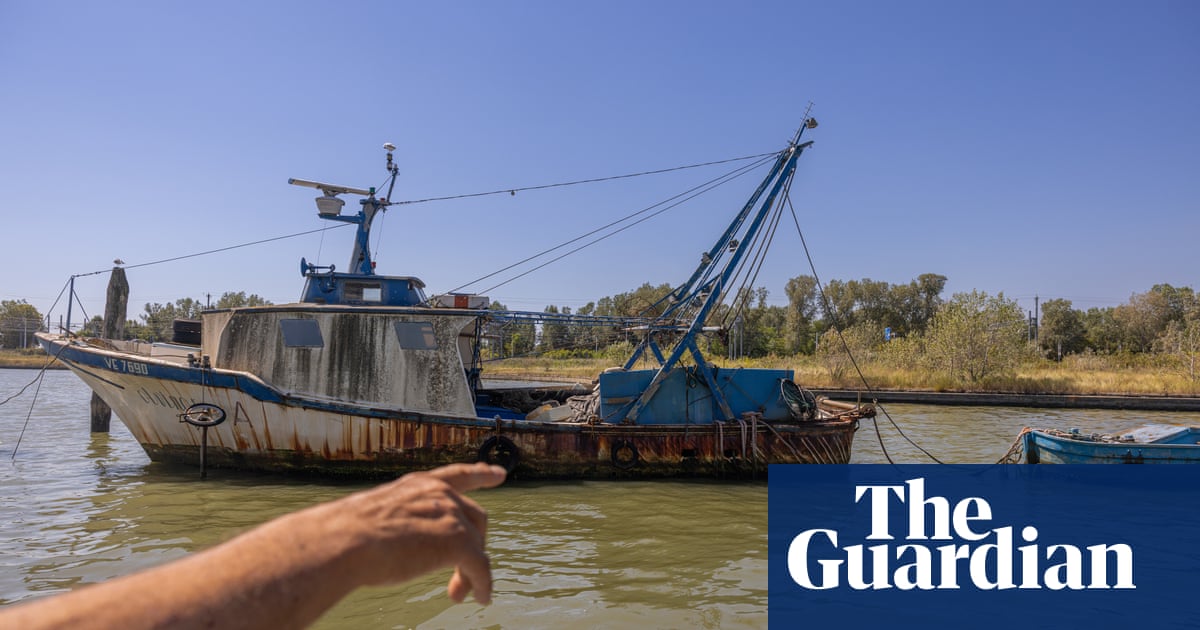
Paolo Cuman points to a rusty boat, half-sunk in Venice’s lagoon. “It has been there for years,” he says, laughing. “When I manage to have her removed, I’ll open a bottle of good wine.” Hunting abandoned boats is a hobby for Cuman, the coordinator of the Consulta della Laguna Media, a grassroots group monitoring the health of the lagoon. Once he’s found the boats, he maps them and pressures the authorities to remove them.
For decades, the Venetian lagoon – the largest wetland in the Mediterranean – has been used as a landfill by people wanting to get rid of their boats. An estimated 2,000 abandoned vessels are in the lagoon, scattered over an area of about 55,000 hectares (135,900 acres). Some lie beneath the surface, others poke above the water and some are stranded on the barene – the lowlands that often disappear at high tide.
The wrecks are a threat to other vessels – a boat’s engine may be damaged if it passes over them. But they are an even bigger threat to the ecosystem, leaking chemicals, fuel and microplastics as the boats disintegrate in the water.
Authorities seldom remove these wrecks; bureaucracy is slow and dealing with the city’s boat graveyards is a long way down the priority list. That’s why a group of boating enthusiasts and environmentalists, including Cuman, are trying to force action.
On a hot summer day, the lagoon, which is only a few miles away from the crowded streets of Venice, feels like a world away. Sailboats zigzag across the water, cormorants fly past and flamingos wade in the shallows, while fish leap in and out of the water.
Only the wrecks of abandoned vessels mar the scene. For the most part they are small, low-powered motorboats, or burci – transport boats widely used in Venice. These are “owned by ordinary people”, says Cuman.
He spots the relic of a vessel: “See this fishing boat? I remember when it used to bring the fish to Mestre [his neighbourhood] 40 years ago! Looks like it has been discarded for three decades at least,” he says.
The practice of illegally abandoning vessels in the lagoon dates back to the 1950s, when trucks began to replace boats for commercial purposes. “In the past, the large shipping companies abandoned the burci here, creating boat cemeteries,” says Giovanni Cecconi, president of Venice Resilience Lab, an environmental group that has contributed to mapping the lagoon.
“There are boats that have been abandoned for 20 or 30 years that are in very bad condition,” says Davide Poletto, executive director of the Venice Lagoon Plastic Free organisation. These release chemical contaminants as they break down, he says.
Modern boats tend to have fibreglass hulls, which release microplastics as they decompose. A big concern is anti-fouling paints, which are intended to keep slime, barnacles and other creatures off the boats. Some of these, such as tributyltin, are now banned because of their toxic effects on marine life. Even the boats’ furnishings and upholstery contain chemicals that may contaminate the water.
To a Venetian, owning a boat is almost like owning a car. But while a car might end up in a salvage yard, disposing of an unserviceable boat is complicated and expensive. Venice lacks the infrastructure to deal with unwanted boats; few facilities take them so many choose to abandon them.
The Venice lagoon is controlled by 26 different entities, which means it is not always clear who has responsibility.
“Even if a local policeman sees an abandoned boat on a sandbank, he cannot intervene to remove it, because it is not his jurisdiction,” says Paolo Ticozzi, a city councillor who says he has asked authorities to create a disposal site for abandoned boats, but has yet to receive an answer.
Consulta della Laguna Media says it is the only organisation mapping the wrecks, and that it only covers the northern part of the lagoon.
No attempt has been made to quantify the environmental impact of the vessels, according to Venice Lagoon Plastic Free.
“No one has thought of analysing the damage caused by boats that have been there for 20, 30 or even 40 years,” says Poletto. The association has funding to remove some of the wrecks and plans to collect and examine some of the sludge at those sites.
Venice is far from the only boat graveyard. About 3m shipwrecks of all kinds are scattered across the world, according to Unesco. In the UK, hundreds of boats lie abandoned along the coasts of Devon and Cornwall, according to a BBC report, which called the practice “the fly-tipping of the maritime world”.
In the US, a Washington state programme has removed about 900 abandoned boats from rivers since 2002. In 2021, Virginia created a working group to “coordinate an examination of the issues” around abandoned and derelict vessels.
“The situation must be evaluated case-by-case,” says the bioscientist Prof Monia Renzi. “Obviously, a boat that has just been sunk should be recovered, if technically possible, because it could release a large number of contaminants even from parts we don’t normally think of, like upholstery.”
It can be different for vessels that have been lying on the sea – or riverbed for many decades, where an ecosystem has formed around the ships: “Marine sedimentation above the wreck limits the spread of contaminants,” says Renzi, adding that removing some of the oldest wrecks could cause further damage.
When it comes to Venice’s lagoon, however, the best solution is usually to remove the wrecks regardless of their age, says Renzi, especially because shallow waters make recovery easier.
Bulky material like boats can reduce the water’s natural circulation, she says, damaging the wider ecosystem – the less water circulates, the more pollutants will stick around. These environments are “already under pressure, because they are highly exploited for fishing, so the possible transfer of contaminants can be extremely critical”, she says. It risks further damaging fish populations.
In Venice, however, activists have won a small victory. The authority responsible for water management in the Venetian lagoon, the Magistrato alle Acque, has agreed to remove some vessels in the coming months.
Cuman welcomes the news, but says a lot remains to be done.
It is not only a problem for the environment, he says, but also of transport within the lagoon: “Unbound boats are at the mercy of the wind and the current. If you pass over a sunken or semi-sunken boat, it can break the engine, causing considerable damage,” says Cuman. Broken-off boat parts floating on the currents can also cause accidents hundreds of miles from the wreck, he says.
Cuman wants more people to join his wreck-spotting missions. “If I convince others in this community to join me, then there will be a Venetian patrolling every spot of the lagoon. Ignoring us will become impossible.”












